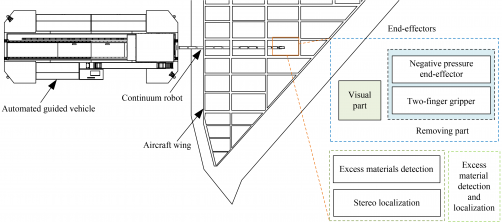Excess materials left inside aircraft wings during assembly pose significant risks to flight safety. These materials, including nuts, rivets, and aluminum shavings, can interfere with the operation of critical components, potentially leading to serious accidents. To address this issue, researchers at Beihang University have introduced an innovative approach in their study titled “Detection and Removal of Excess Materials in Aircraft Wings Using Continuum Robot End-Effectors.”
The project aims to enhance the efficiency of detecting and removing unwanted materials in the confined spaces of aircraft wings, which are challenging for traditional manual and robotic methods. The study leverages a continuum robot equipped with a removal end-effector and a stereo camera to perform the task effectively.
To begin, the research team analyzed the size and weight characteristics of excess materials typically found in aircraft wings. They designed two specialized tools: a negative pressure end-effector for small items like nuts and small rivets, and a two-finger gripper intended for larger volumes of aluminum shavings. This dual approach allows for a comprehensive strategy to tackle the issue of excess materials.
The research also addresses the difficulty of working in poorly lit environments. The team integrated supplementary lighting devices to enhance visibility within the wing compartments. This improvement is crucial since effective detection relies on clear imaging.
For material detection, the study employs the You Only Look Once (YOLO) v5 algorithm to classify and identify excess items. The researchers constructed two training datasets tailored for two types of aircraft wings. Given the limited texture features available in the wing interiors, they implemented an image-matching method based on YOLO v5 detection results. This strategy effectively mitigates the performance instability often associated with other feature point matching techniques.
Experimental results demonstrate the effectiveness of this approach. The detection accuracy for excess materials exceeds 90%, and the visual localization error remains below 2 mm for four different types of excess objects. The combination of the continuum robot and the developed end-effectors proves successful in efficiently removing unwanted materials from aircraft wings.
The findings are detailed in the paper authored by Xiujie Cao, Jingjun Yu, Siqi Tang, Junhao Sui, and Xu Pei. The full text of the study is available at https://doi.org/10.1007/s11465-024-0806-2. This research marks a significant advancement in aircraft maintenance technology, promising to enhance safety and operational efficiency in the aviation industry.
